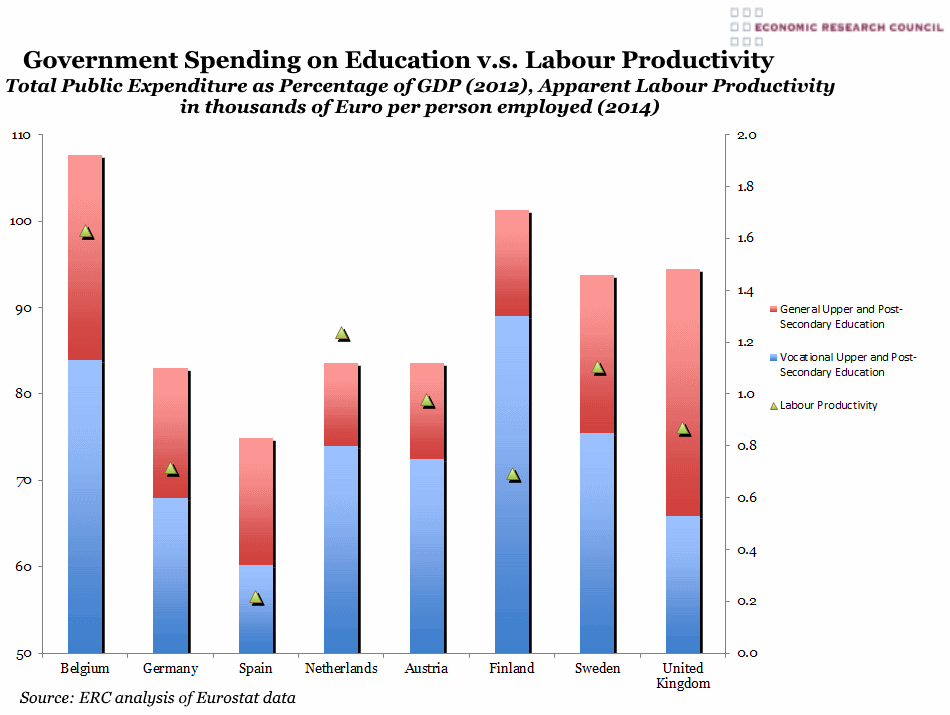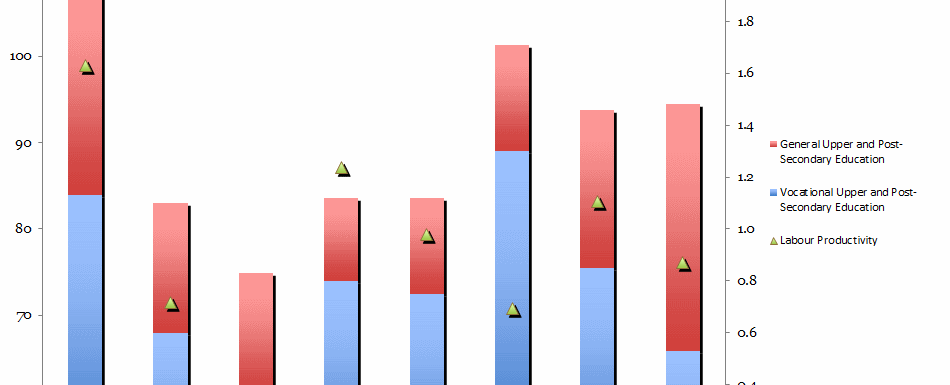
Summary
The chart shows that the UK, when compared to other EU countries with strong economies, has one of the lowest levels of spending on vocational education as a percentage of GDP (under 1.5%). Despite this shortfall in public spending on vocational education, the UK maintains average productivity levels in manufacturing indicating that this is being boosted by private sector training schemes. A report on young workers released today stated that if the UK could reduce the percentage of NEET young people (not in education, employment or training) from 17% to 10%, it would enjoy an additional £45billion in economic growth.
What does the chart show?
The stacked bars show total Government expenditure on education for those at upper and post-secondary level (in the UK this is aged 14 plus), broken down into vocational in blue, and general in red. It is shown as a percentage of GDP against the right hand axis and does not include university spending.
The green triangles denote Apparent Labour Productivity or in other terms, after accounting for subsidies and indirect taxes, it is the value added per person employed. It is measured against the left hand axis in thousands of Euros.
We sought to allow time between the data sets for the education spend to take effect, however two years’ difference was as big a lag as the available data would allow. The education data is from 2012 whereas the productivity data is from 2014, which should at least take into account some of the effect of education spending.
Why is the chart interesting?
In his statement to the Commons on the assurances that the UK government offered in its recent deal with Nissan, Secretary of State for Business, Greg Clark said that he had promised to make ‘support … available to firms for skills and training of the local workforce’. Effectively this marks government recognition of the need for increased spending on vocational training in the drive to keep the post-Brexit UK car industry competitive and may also reflect Nissan’s reticence to make up the shortfall in skills and training entirely unaided. Although this has been on the government agenda for quite some time, as they have previously pledged to up the number of apprenticeships by 3 million by 2020, Brexit will likely increase this pressure. Part of the issue in the UK is the stigmatisation of vocational training, something often undervalued in educational terms, despite 59% of graduates between 2005-2010 working in roles not requiring a degree.
Looking at Germany, a nation often stereotyped for its efficiency, the chart displays relatively low level of labour productivity. This is probably due to the high levels of subsidies available to German manufacturers which this measure strips away from the total labour productivity. Germany runs a ‘dual education system’ that amalgamates vocational and formal training, as well as protecting 500,000 company-based training contracts in law.
The Netherlands appears to spend more on vocational training as a percentage of GDP, but this is due to their lower population. In a comparative study looking at vocational training in the UK and The Netherlands, a study found that while British engineering companies are devoting more resources to initial and continuous training, the widespread provision of full‐time vocational education in The Netherlands enables Dutch employers to further train candidates to technician and craft levels more quickly and cost‐effectively.
Most significantly, the Young Workers report today also stated that were the OECD 35 countries to follow the German model in training and education of the young, the world would be $1.1 trillion better off.

